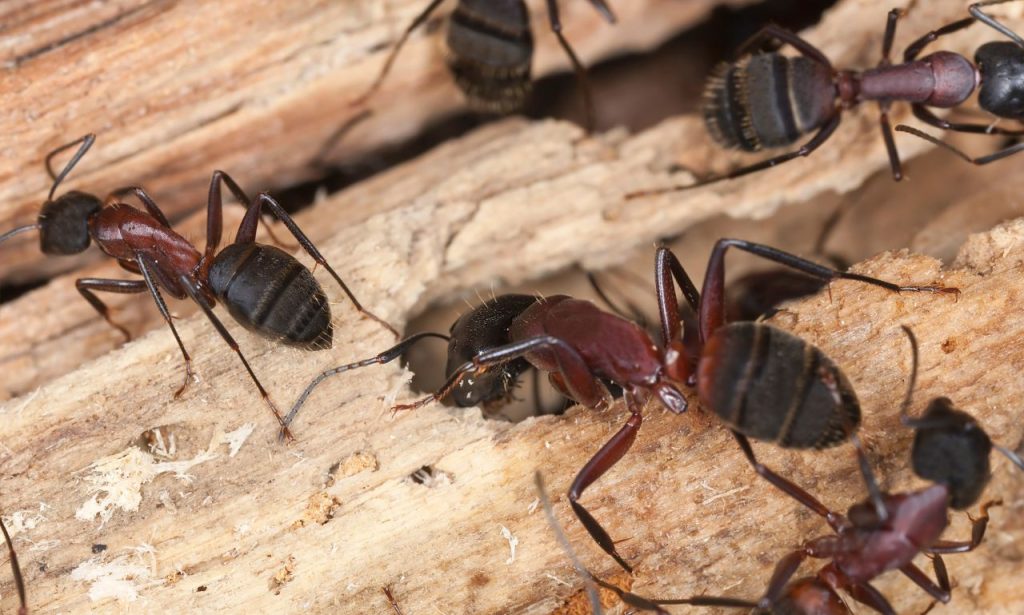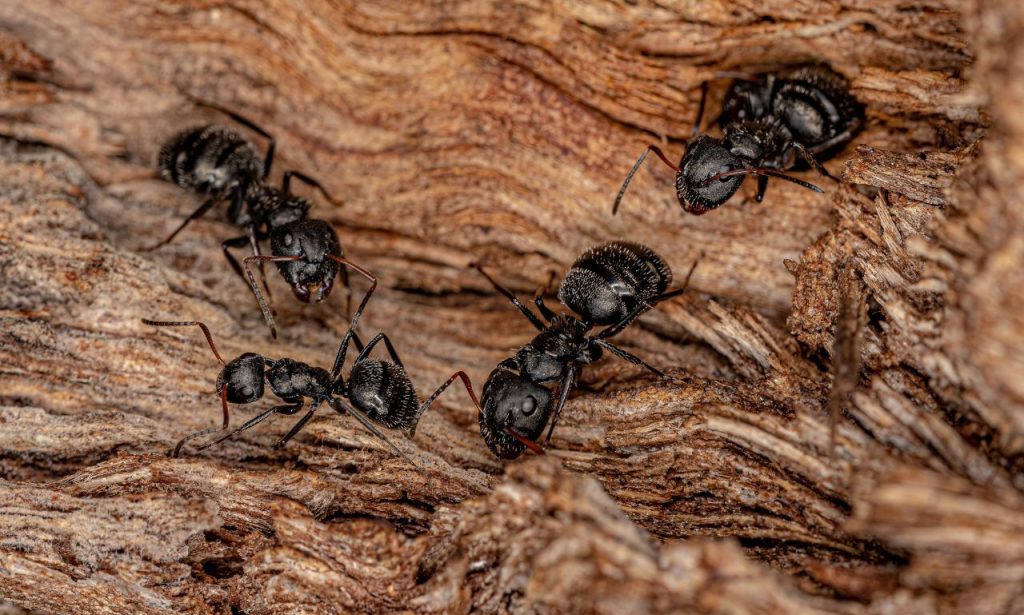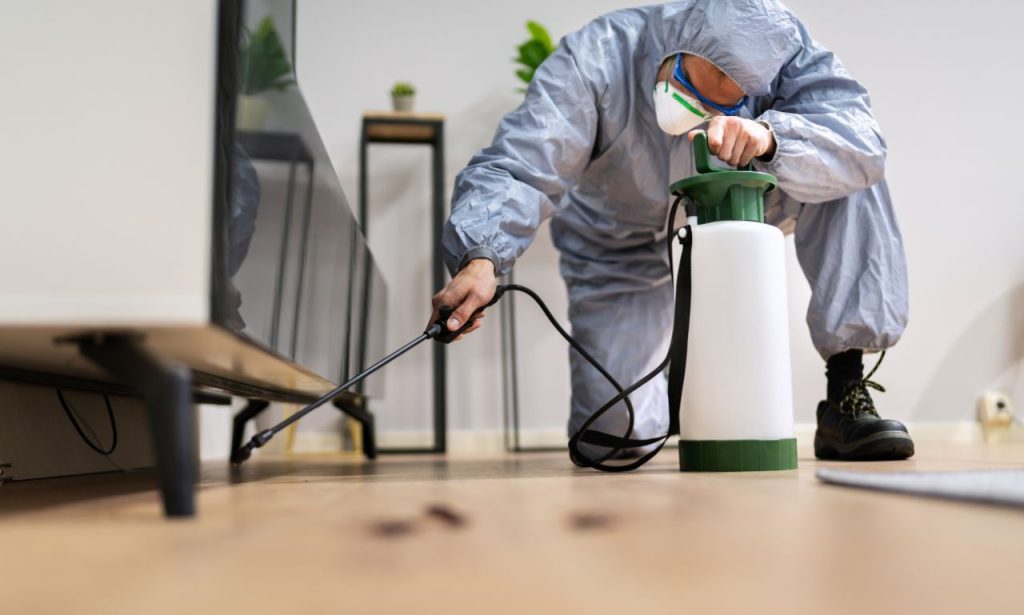Carpenter ants love to invade your home for many reasons. If you’ve been noticing these pesky insects around, it’s because there’s something about your environment they find irresistible. Let’s delve into what attracts carpenter ants and how you can keep them at bay.
Factors That Attract Carpenter Ants
Moisture Issues
Carpenter ants are obsessed with moisture. Excess moisture around your home is like a flashing neon sign, inviting them in. They need damp environments for their survival, and often, moisture issues around your house create the perfect conditions.
- Water Leaks: Carpenter ants are quick to settle near dripping faucets or leaking pipes. They love moisture-laden places like bathrooms, basements, or even kitchens. Any place where there is a constant water source is a potential nesting site for carpenter ants. Regularly inspecting for leaks and promptly fixing them is key in preventing carpenter ants from settling in your home.
- Damp Wood: Wood damaged by water—whether due to leaking gutters or roof leaks—is a massive attractant for carpenter ants. They will tunnel through moist wood easily, making themselves comfortable and setting up camp. Wet wood becomes softer, which allows these wood-destroying insects to chew through it effortlessly. Carpenter ants do not eat wood like termites, but instead excavate it to create their tunnels and nests.
- Buildings with Water Damage: Buildings that have suffered damage from water—including floods, roof leaks, or even consistent high humidity—are prime targets for carpenter ants. Water-damaged wood and high-moisture areas inside your home can quickly become the hub of carpenter ant activity. Carpenter ants need the moisture to maintain their body temperature and prevent dehydration.
Decayed Wood

Carpenter ants love building nests in decayed wood. It’s easier for them to chew through soft, decaying wood compared to sound wood, and it serves as a perfect nesting spot.
- Decaying Wood and Damaged Wood: If you have old stumps, dead trees, or decaying wood structures near your home, these can become breeding grounds for carpenter ant colonies. Carpenter ants seek out wood that has already been softened by water damage, decay, or other insects because it is easier for them to tunnel through.
- Dead Tree Stumps and Logs: Dead trees and logs that have been left around your property can become perfect nesting sites for carpenter ants. These insects are attracted to the soft, decaying wood found in tree stumps, making them ideal conditions for setting up a carpenter ant nest.
- Wood Shavings: Keep an eye out for wood shavings around wooden structures—a telltale sign that carpenter ants are turning them into their new home. These shavings are often mixed with carpenter ant excretions, another clear indicator. Wood shavings are left behind as carpenter ants tunnel through wood to create galleries for their colonies.
Accessible Entry Points
Carpenter ants are sneaky invaders. They exploit every crack and gap to gain entry.
- Cracks Around Doors and Windows: Cracks around doors, windows, utility lines, or even the foundation can be entry points for these ants. Carpenter ants need an access point to enter homes, and even the smallest gap or crack can provide this entry.
- Tree Limbs and Branches: Overhanging tree branches touching your house can serve as bridges for carpenter ants to access your home. It’s like giving them a ready-made highway straight to your attic or roof. Tree branches that are in contact with the roof or side of your house give ants easy access to wooden structures where they can nest.
- Wall Voids and Utility Lines: Carpenter ants are particularly skilled at finding wall voids, cracks in the foundation, or gaps around electric and plumbing lines to enter the house. These ants use wall voids to travel within your house and create satellite colonies that are connected to the main nest, which is often outdoors. Proper sealing of utility lines and regular inspections are essential in preventing their entry.
Readily Available Food Sources
The presence of carpenter ants often comes down to the availability of food sources. If they can find what they’re craving in your home, they will be your uninvited guests.
- Sweet Food: Carpenter ants have a strong attraction to anything sugary. Food crumbs, cooking grease, cat food—even sugar milk—can be irresistible to them. They are especially drawn to honeydew, which is produced by aphids and scale insects. Honeydew is their favorite food, and if there are plants around your house with an aphid infestation, carpenter ants will be close by.
- Pet Food and Food Particles: Uncovered pet food is basically an open buffet for these ants. If pet food is left out overnight or stored improperly, it becomes a steady supply of food for ant colonies. Pet food should always be kept in airtight containers to prevent attracting carpenter ants.
- Organic Debris: Bits of food, leftover crumbs, and decaying organic debris are perfect attractants for carpenter ants. Keep your kitchen spotless to avoid attracting these opportunistic pests. Carpenter ants also scavenge dead insects for food, which means that any insect carcasses around your house can attract them.
- Cooking Grease and Leftover Food Crumbs: Cooking grease left on the stove or counters and crumbs from leftover food are major attractants for carpenter ants. Cleaning all cooking surfaces and storing food properly are essential steps to keep these pests at bay.
Carpenter ants are excellent at surviving, but how do they do it? Understanding their behavior helps in finding an effective treatment to combat them.
Signs of Infestation
Knowing the signs of a carpenter ant infestation is essential in tackling it early. The earlier you spot it, the easier it is to prevent a full-blown colony.
- Wood Shavings and Carpenter Ant Sawdust: This is one of the key signs of carpenter ants building nests in wood. It’s not sawdust they eat—they simply discard it as they tunnel through wood structures. Carpenter ants tunnel through wood to create galleries, and in the process, they push out the wood shavings.
- Hollow-Sounding Wood: Carpenter ants tunnel through wood, and over time, wood structures can become hollow and less stable. Tap wooden structures to check for a hollow sound, which may indicate the presence of ants. Carpenter ant damage often makes the wood sound hollow due to the creation of galleries within.
- Activity of Carpenter Ants: Carpenter ants are more active during the night. If you notice black species or worker ants crawling around your kitchen or basement walls at night, you could have a carpenter ant colony nearby. Nighttime activity is a key indicator, as these ants are primarily nocturnal and venture out of their nests in search of food sources.
- Damaged Wood: Carpenter ants tunnel through both decayed and sound wood, often leaving behind smooth, sanded tunnels. These tunnels can weaken wooden structures over time, making them susceptible to structural damage.
Behavior Patterns of Carpenter Ants
Carpenter ants are social creatures. They live in colonies, and understanding their behavior helps in eliminating them effectively.
- Worker Ants and Ant Trails: Worker ants will create scent trails from the nest to food sources. Following these trails often helps in locating the carpenter ant nest. Worker ants are responsible for foraging for food and bringing it back to the colony. They leave a pheromone trail to guide other worker ants to the food source.
- Colonies of Carpenter Ants: Carpenter ants usually form two types of colonies: a parent colony with the queen and several satellite colonies. Satellite colonies are typically found in dryer environments, such as wall voids or hollow doors. The parent colony requires more moisture, while the satellite colonies, which are connected to it, may exist in dryer parts of your home.
- Carpenter Ant Nest Locations: The parent nest is usually located outside in decaying wood, such as a tree stump, while the satellite colonies can be found inside the home in locations like wall voids or behind baseboards.
Nesting Habits

Carpenter ants are notorious for building nests inside wooden structures. They target moist wood but may also settle into sound wood under the right conditions.
- Nests in Wall Voids: Carpenter ants love to create cozy nesting sites inside wall voids, hollow doors, or soft wood structures that provide ample protection. Wall voids often provide the moisture and safety that carpenter ants need to thrive.
- Conditions for Nesting: Moisture issues and access to food sources are the main attractants for carpenter ants to establish nests. Dead wood and structural damage often make for attractive nesting sites. Carpenter ants are drawn to damaged areas because they can tunnel through weakened wood more easily.
- Satellite Colonies and Expansion: Satellite colonies are created as the carpenter ant colony grows, with worker ants establishing new nests in areas like basements, attics, and hollow spaces within walls. These colonies are connected to the parent colony and help expand the carpenter ant population.
Preventive Measures
Getting rid of carpenter ants is easier if you prevent them in the first place. Here’s how you can stop them from making your home their own.
Regular Home Maintenance
- Fix Water Leaks: Carpenter ants are attracted to water. Fix any water leaks, dripping faucets, or damaged pipes. Check areas that often have excess moisture, like basements, bathrooms, and kitchens. Repairing leaks and maintaining proper ventilation can eliminate the moisture issues that attract carpenter ants.
- Clean Gutters: Make sure gutters are clean and free of debris. Clogged gutters can lead to water buildup and damp wood, both of which attract carpenter ants. Clean gutters help prevent excess moisture from accumulating around your home.
- Seal Entry Points: Use caulk to seal cracks around doors, windows, and utility lines. This will prevent carpenter ants from accessing your home through these routes. Ensuring that all entry points are sealed is one of the most effective methods for keeping carpenter ants out.
- Inspect Wooden Structures: Regularly inspect wooden structures around your property for signs of carpenter ant damage. Look for wood shavings, sawdust, and hollow-sounding wood to catch infestations early.
Proper Food Storage Techniques
Keep all food items tightly sealed. Leaving out even small amounts of food attracts carpenter ants.
- Store Pet Food Properly: Keep pet food in airtight containers and avoid leaving it out overnight. Pet food left out is a major attractant for carpenter ants and should always be stored in sealed containers.
- Clean Kitchen Surfaces: Wipe down surfaces, including countertops and under appliances. Cleaning grease, bits of food, and sugar spills is essential for keeping carpenter ants away. Food crumbs and cooking grease are some of the biggest attractants for carpenter ants, so a clean kitchen is crucial.
- Dispose of Food Waste Properly: Make sure to dispose of food waste in tightly sealed trash cans. Carpenter ants are opportunistic feeders, and improperly disposed of food waste can attract them.
Effective Landscaping Strategies
Proper landscaping can help reduce the attraction of carpenter ants.
- Trim Tree Limbs and Branches: Keep branches and tree limbs away from the house. Carpenter ants often use these as pathways to access buildings. Tree branches that touch the house act as bridges, allowing ants easy access.
- Remove Decaying Wood: Get rid of decaying tree stumps, logs, and dead trees from your property. They can become the perfect breeding grounds for colonies of carpenter ants. Removing sources of decaying wood reduces the likelihood of carpenter ants nesting near your home.
- Avoid Storing Wood Piles Near Your Home: Store wood piles away from the house and ensure they’re elevated. Carpenter ants are attracted to wood, especially if it’s damp or decayed. Keeping firewood dry and away from the home can help prevent carpenter ants from invading.
- Proper Drainage: Ensure that water drains away from the foundation of your home. Poor drainage can lead to excess moisture in the soil, attracting carpenter ants.
When Should I Contact Professional Pest Control?
Carpenter ants can cause significant structural damage if left unchecked. In severe cases, professional intervention is the best solution.
Identifying Severe Infestations
If carpenter ant damage is extensive, DIY treatments might not be enough. Signs you might need professional help include:
- Widespread Carpenter Ant Activity: If you notice worker ants in multiple locations around your home, it could indicate a larger infestation. Carpenter ant colonies can expand rapidly, and visible activity in different areas may mean several satellite colonies have formed.
- Visible Structural Damage: Carpenter ants compromise structural integrity by tunneling through wood. If you notice hollow-sounding wood or structural damage, it’s time to call in the professionals. Structural damage caused by carpenter ants can threaten the stability of wooden structures, making timely intervention critical.
- Failed DIY Treatments: If home treatments and ant control products are not solving the problem, a professional pest control service is necessary. Professionals have access to more powerful and effective treatment options.
Benefits of Professional Intervention
Professional pest control services can provide an efficient solution to a carpenter ant problem.
- Comprehensive Termite Control and Ant Control: Professionals can identify the difference between carpenter ants and termites, ensuring the right treatment plan is used. Many people mistake termites for carpenter ants, and treating them incorrectly can lead to further issues.
- Effective Treatment Plans: A professional pest control team will use effective methods, such as non-repellent sprays or ant traps, that specifically target carpenter ants while ensuring safety for your family. Non-repellent sprays are particularly effective because ants cannot detect them, allowing the treatment to be more successful.
- Future Infestations Prevention: Pest control services also provide preventive measures, such as sealing entry points and eliminating moisture sources, to keep carpenter ants from returning. Pest control teams can also advise on how to maintain your home to prevent future infestations.
- Expert Knowledge: Professionals have a wide range of knowledge on how to locate and eliminate carpenter ant colonies, including those in hard-to-reach places. Their expertise allows them to use biological control measures and treatment options that might not be available to homeowners.
Choosing the Right Pest Control Service

When choosing a pest control service, opt for one with experience dealing with carpenter ants.
- Family Owned & Operated: Smaller, family-owned services may offer personalized plans. These companies are often more invested in providing excellent service and ensuring customer satisfaction.
- Reviews and Expertise: Check customer reviews and ask about their experience with carpenter ant infestations. Choosing a company that specializes in ant control and has a good track record ensures that you get the best possible service.
- Treatment Options: Ask about the types of treatments they use and whether they provide options like non-repellent sprays, insecticide bait, or bait traps. Understanding the treatment plan helps you feel confident that the problem will be resolved.
If you’re dealing with a carpenter ant infestation, don’t wait—act now to protect your home. Contact a professional pest control service to regain your peace of mind and keep your home safe from these wood-destroying pests.
ALSO READ: How to Prevent and Remove Wasp Nests from Your Yard
FAQs
Carpenter ants have a defined waist, bent antennae, and larger bodies compared to termites. Termites, on the other hand, have straight antennae and a more uniform body.
Natural methods include sealing entry points, cleaning food crumbs, and eliminating excess moisture. You can also use insecticide bait to deter them.
Carpenter ants are attracted to sugary substances and accessible food sources. Cooking grease, food crumbs, and sweet food left out can all attract these ants.
Yes, carpenter ants tunnel through wood, which can lead to structural damage over time, especially in damp or decayed wood areas.




